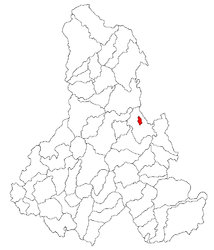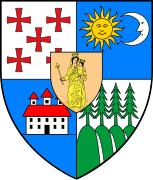Bălan
Bălan (German: Kupferbergwerk; Hungarian: Balánbánya, pronounced [ˈbɒlaːmbaːɲɒ] (![]()
Bălan Balánbánya | |
|---|---|
 Coat of arms | |
 Location in Harghita County | |
 Bălan Location in Romania | |
| Coordinates: 46°38′59″N 25°48′36″E | |
| Country | |
| County | Harghita |
| Government | |
| • Mayor | Gheorghe Iojiban[1] (Ind.) |
| Area | 2.33 km2 (0.90 sq mi) |
| Population (2011)[2] | 6,115 |
| • Density | 2,600/km2 (6,800/sq mi) |
| Time zone | EET/EEST (UTC+2/+3) |
| Vehicle reg. | HR |
| Website | www |
Geography
It lies in the Ciuc Depression (Romanian Depresiunea Ciucului, Hungarian: Csíki-medence). It is surrounded by the Hășmaș Mountains (Hășmașul Mare and Hășmașul Mic). The town's altitude is 850 m; this rises to 1792 m at the highest peak of the Hășmaș Mountains. Bălan is crossed by the Olt River.
Climate
The temperate continental climate has an average temperature of 7˚C, falling to -10˚C in winter. There are 1300-1400 sunny hours per year. Wind gusts are rare due to the surrounding mountains and forests.
Flora and fauna
Most of the forests around Bălan are spruce forests, but there are also fir, larch and maple forests. There are some flowers species in the area like edelweiss and sweet pea which are protected by law. In the forests there are some edible mushrooms species and fruits like blueberries, raspberries and cranberries.
Demographics
| Year | Pop. | ±% |
|---|---|---|
| 1977 | 12,161 | — |
| 1992 | 10,937 | −10.1% |
| 2002 | 9,295 | −15.0% |
| 2011 | 5,864 | −36.9% |
| Source: Census data | ||
According to the census from 2011 it had a population of 5,864 of which 3,625 (61.82%) were Romanians, and 2,124 (36.22%) were Hungarians.[3]
History
Bălan was the site of iron mining during the 17th century, but by 1702 the iron stores had been depleted. The copper deposits were discovered in 1785 by János Opra; production began in 1803, and by 1853 six mines were in operation. From that period, the village gradually began to develop into a town. Until 1967, Bălan remained part of the commune of Sândominic, finally gaining official town status in 1968. In 2006 all mining-related activities were stopped by the Romanian government and nowadays the city is counting on ecotourism and small businesses as main economical activities.
Points of interest
Bălan's main architectural site is the Roman Catholic Church, consecrated in 1869. Despite the environmental blight of the mining, the surrounding area is uncommonly beautiful, taking in the nearby mountains of Hășmașul Mare and Tarcău, the former a popular hiking destination. The river Olt, one of Romania's most significant, originates in the mountains near the town.
References
| Wikimedia Commons has media related to Bălan. |
- "Results of the 2016 local elections". Central Electoral Bureau. Retrieved 3 April 2020.
- "Populaţia stabilă pe judeţe, municipii, oraşe şi localităti componenete la RPL_2011" (in Romanian). National Institute of Statistics. Retrieved 4 February 2014.
- Romanian Census 2011
